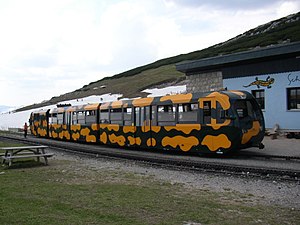NÖSBB salamander
| salamander | |
|---|---|
| Numbering: | 11/21/31 / Baby1–13 / 23/33 / Baby3 |
| Number: | 3 |
| Manufacturer: | Waagner-Biro, Hunslet-Barclay, Swoboda / carvatech |
| Year of construction (s): | 1999/2011 |
| Gauge : | 1000 mm ( meter gauge ) |
| Length over coupling: | 30,416 mm |
| Empty mass: | 41.25 t |
| Top speed: | 19.5 km / h |
| Installed capacity: | 544 kW / 740 PS |
| Gear system : | Dept |
| Number of drive gears: | 4th |
| Number of brake gears: | 8th |
| Motor type: | CAT diesel |
| Rated speed: | 1,800 rpm |
| Power transmission: | hydrodynamic |
| Inertia brake: | VOITH retarder |
| Operating mode: | 0/0 |
| Gradient: | 20% |
| Seats: | 119 |
As Salamander railcars are since 1999 on the Schneebergbahn used in Lower Austria cog railway - DMUs designated.
In October 1998, the future plans for the Schneeberg Railway were made known to the public: The Salamander design of the new generation of diesel railcars was presented. The first set was delivered on April 8, 1999. On July 24, 1999, these were used for the first time alongside the traditional steam locomotives. On September 11, 1999, a ceremony was held for the christening of the Salamander railcars and the official commissioning of the new workshop in Puchberg am Schneeberg . The three railcars were named Franz Joseph , Sisi and Leo after Leo Arnoldi , the builder of the railway.
The diesel engine used in the Salamander was considered one of the most modern in the world at the time of its construction and also complied with the particularly strict Californian emissions regulations. Its exhaust gases are passed over a catalytic converter . A maximum noise level of 76 decibels is achieved through sound insulation. This level corresponds to the noise development of a modern comfort coach. The vehicles are equipped with three independent brake systems for optimum safety. The drive head can be both with his own set and used with the car of the steam operation - a practice that has been widely practiced in heavy passenger rush as only two own car sets were available for the three power heads.
The two passenger cars are equipped with air suspension, which enables optimal running properties. Unlike the wagons of the steam trains, whose compartments are entered individually through external doors, the salamander wagons have central entrances and a central aisle. With five seats per row (seating 6 + 4), however, this leads to somewhat more cramped space in the meter gauge vehicles than in the previous generation. The uphill car is designed as a control car with a driver's cab.
In 2011 a further Salamander control car + intermediate car were purchased from the company carvatech (formerly Swoboda). With the existing third salamander locomotive, a third salamander set has been in use since then.
Since 2006, the so-called “baby salamander” has also been going up the Schneeberg. This sidecar is used to transport goods to supply the refuges on the Schneeberg. In design and shape, the “baby salamander” resembles a scaled-down salamander locomotive. Another was put into operation in 2008.
Individual evidence
- ↑ Schneeberg cog railway - the first new locomotive and set will arrive tomorrow in the OTS on April 7, 1999, accessed on May 5, 2019
- ↑ "Salamander" on the Schneeberg in the OTS of September 11, 1999, accessed on January 21, 2010

